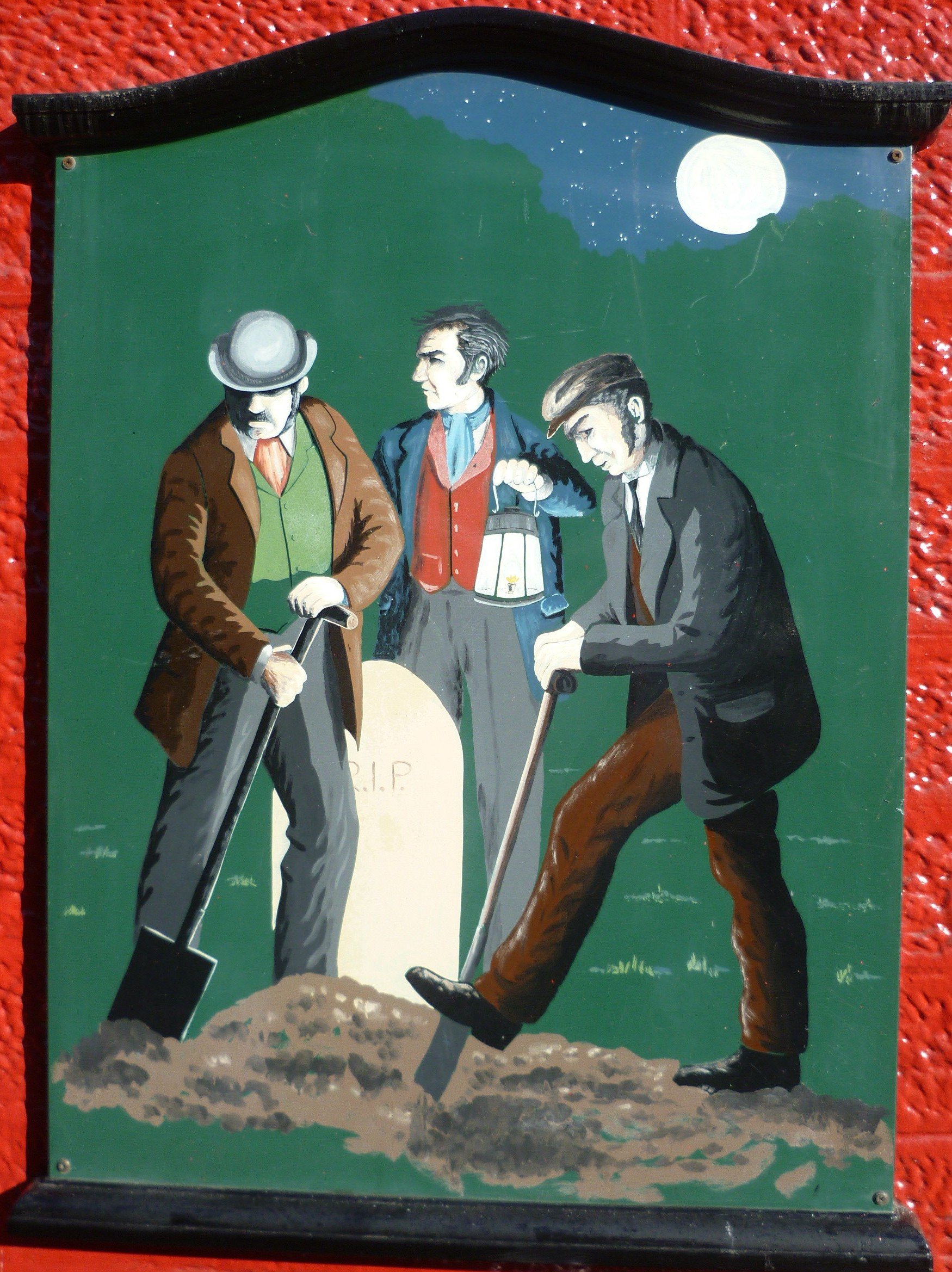Spooky Topics in Medical History
Content Warning: Disease, Blood, Death, Cadavers
Intended for readers 13 and up
In honor of Halloween, let’s learn about some spooky topics from medical history. Do you know how a disease inspired fashion trends? Or why bird-beaked plague masks were used?
Plague doctors
1656 engraving of a Roman doctor
Source: https://www.nationalgeographic.com/history/article/plague-doctors-beaked-masks-coronavirus
The black death was a disease that killed millions of Europeans in the middle ages. The spread of the disease occurred throughout centuries, including through the 17th century when the plague doctor outfits were used. Now known as the bubonic plague, the black death was caused by a bacteria called Yersinia pestis (Y. pestis). The bacteria was carried throughout Europe by rats who had infected fleas in their fur. The bubonic plague caused symptoms such as fever, pains, and large swollen lymph nodes in the neck that would ooze pus.
Today this kind of disease would be cured quickly through the use of antibiotics. But the people of the day were still centuries away from germ theory (that germs can make us sick), and had no idea what was causing this illness. Instead of microbes (bacteria), the physicians in the 17th century believed that bad smelling air, or “miasma” was to blame for sickness; they called this the miasma theory. Strong, sweet smells were thought to counteract the poisoning effects of miasma. Perfumes and incense were common remedies used to try to combat the symptoms of the bubonic plague.
16th century plague doctor’s mask in the German Museum for the History of Medicine
Source: https://designyoutrust.com/2020/02/an-authentic-16th-century-plague-doctor-mask-preserved-and-on-display-at-the-german-museum-of-medical-history/
The plague doctor outfit was used to try to ward off disease in the 17th century by some physicians that believed in the miasma theory. The outfit fully covered the doctor, including breeches connected to boots, a tucked in shirt, gloves, and a hat. The doctors carried a rod in order to poke or fend off patients from getting too close to them. A long coat covered in scented wax, and most iconically a bird shaped mask, completed the look. The mask included goggles, and the beak was filled with a mixture of herbs and other potently scented ingredients. The long shape of the beak was thought to give the miasmic air enough time to go through the mixture before reaching the nose and mouth.
Surprisingly, although miasma theory wasn’t correct, the costume still may have protected the physicians from infection. The doctors were prevented from coming in direct contact with the skin or fluids of diseased patients and the intimidating beak masks worked similarly to how we use masks today to protect against the virus that causes Covid-19. Unfortunately, since physicians were under-equipped to deal with disease, the plague wasn’t fully managed until germ theory and the development of antibiotics in the early 20th century.
bloodletting
An illustration of bloodletting from 1675
Source: https://www.nationalgeographic.com/science/article/bloodletting-is-still-happening-despite-centuries-of-harm
19th century bloodletting fleam. The four blades folded into the shield like a swiss army knife.
Sourcehttps://www.gilai.com/product_1234/Bloodletting-Fleam-Brass-and-Steel
Bloodletting is one of the oldest medical practices in history. It started among the Egyptians and has been used by many civilizations and cultures throughout time, including ancient Greece, India, the Middle East, and Medieval Europe. There were different methods of bloodletting. One main method was puncturing a vein or artery using instruments called “lancets” or “fleams”. Most commonly, the median cubital vein at the elbow was used for this. A second method worked by scraping the skin and then cupping that scraped area, which involved using a flame to pull the air out of a glass dome so that when the dome was applied to the skin it created suction. Leeches were a third method that were also used in bloodletting. There was a specific type of “medicinal” leech used which was able to suck up blood almost ten times its own weight.
In Greece the use of bloodletting became widespread because of Hippocrates’ theory of the “four humors”. He believed that the humors (blood, phlegm, yellow bile, and black bile) needed to be in perfect balance to maintain health. Physicians thought that an overabundance of blood was the cause of most health issues, and that letting out some of the blood would cure disease. These practices in ancient Greece quickly spread to other areas.
Illustration of a woman using leeches for bloodletting from 1639.
Source: https://commons.wikimedia.org/wiki/File:Leeching-large.jpeg
Bloodletting was used in medieval Europe to treat all kinds of diseases. At this time, trained medical doctors as we know them today did not exist. Monks and priests often acted as physicians, although in 1163, they were prohibited by the church from performing bloodletting. This left another medically practicing group, barber surgeons, to perform most of the bloodletting.
While barbers in medieval times cut hair like they do now, they also did much more. They extracted teeth and performed cupping, and bloodletting, and even things like amputations and treating venereal disease. Because of this they were appropriately called “barber surgeons”. Here’s a spooky fun fact: the red and white stripes on the barber pole may have started as a way to represent blood and bandages.
Red and white barber pole
Due to the lack of other treatments, bloodletting was common practice until the late 18th century. Even one of the most prominent American figures was a proponent of bloodletting: George Washington asked for and was given bloodletting after he had a cold and sore throat that caused him to have trouble breathing. Washington was bled several times by different doctors, totalling 5-7 pints of blood drained in 16 hours. Unfortunately, either the disease, the bloodletting, or both, led to his death on December 14th, 1799.
Eventually, the medical community realized that bloodletting often harmed instead of helped the patients they were trying to treat. Bloodletting was phased out of practice over the course of the 19th century as other treatments became more common. Development of anaesthetic and clean surgery techniques allowed surgery to become a more viable option for internal damage. Discovery of antibiotics led to easy treatment of most bacterial infections. Vaccines led to the eradication of many diseases altogether! Although there are things like cancer that modern medicine is still learning how to treat effectively, we have progressed far past the use of bloodletting.
Tuberculosis and fashion
Painting of a woman dying of consumption by Richard Tennant Cooper in 1912
Source: https://www.cbc.ca/news/canada/newfoundland-labrador/apocalypse-then-pandemic-fashion-doomed-beauty-1.5808703
Tuberculosis (TB) has gone by many names throughout ancient and more recent history. This disease has been around for tens of thousands of years and is caused by the bacteria Mycobacterium tuberculosis (M. tuberculosis). The first written records referencing TB was found on an ancient Egyptian papyrus. The ancient Greek physician Hippocrates described the disease “Phthisis” which historians believe to be tuberculosis. In the 1700 and 1800s it was commonly referred to as “consumption” because the disease caused extreme weight loss and seemed to consume the person. It was also referred to as “the white death” because the afflicted patients were incredibly pale. It was at this time in the Victorian Era that TB reached epidemic proportions. Between 1780 and 1850, TB caused 25 percent of all deaths in Europe.
A portrait of a young woman named Marie Duplessis who later died from consumption
Source: https://commons.wikimedia.org/wiki/File:Marie_Duplessis_(1).jpg
People in Victorian England who caught tuberculosis had the possible symptoms of coughing, diarrhea, and coughing up blood or phlegm. So how did such a disease lead to shaping the beauty standards at the time? TB causes weight loss and a stooped posture, extremely pale skin, sparkling eyes, silky hair, rosy cheeks, and red lips. These traits happened to align with the female beauty standards of the time, which favored thinness and paleness as well as natural redness to the lips and cheeks (although in cases of TB this was due to a constant low grade fever). The disease was said to enhance a woman’s natural beauty, and because it wasn’t as gruesome as other prominent diseases of the time (such as smallpox or cholera), it started to influence fashion and beauty standards. It was “in” fashion for women to appear sickly, delicate, and thin. Women started exposing their collarbones and wearing corsets that showed off their small waists. They furthered the illusion by wearing large skirts to make their waists seem even smaller by comparison. Women began to intentionally stoop their posture and wear powder to mimic the pale skin. Makeup was used to rouge their lips and cheeks in order to look consumptive.
Example of late Victorian fashion
Source: https://www.smithsonianmag.com/science-nature/how-tuberculosis-shaped-victorian-fashion-180959029/
Eventually, in 1882 germ theory emerged and people began to realize that microscopic organisms (like bacteria) and not miasma (bad smelling air) was to blame for the diseases that plagued their lives. A large-scale health campaign was started by doctors to slow the spread of germs and of tuberculosis. Unfortunately, physicians and the general public still did not have a full understanding of disease. As a consequence, the health campaign also had an effect on fashion. Women’s skirts became shorter, as the long skirts were thought to be able to sweep in the germs off of the street. Corsets were criticized by health professionals by limiting blood flow and movement of the lungs. “Health” corsets were created with elastic fabrics to try to counteract this.
Although tuberculosis and the fashion it created were long-lasting and far-reaching, modern medicine was eventually able to effectively treat the disease. In 1943, an antibiotic called streptomycin was discovered and quickly used to cure patients of TB. Although tuberculosis still exists today, these antibiotics have largely gotten rid of the disease, and those who get sick are easily treated.
Body snatching
In the early 18th century, an explosion in scientific interest and knowledge led to a large number of people becoming anatomists, medical students, and surgeons. These scientists and medical professionals needed cadavers to study and learn from. However, at the time, the only bodies that were legally allowed to be used for medical dissection were executed criminals whose bodies were donated to medical schools. Because of this, the demand for cadavers far outweighed the supply, and medical schools were forced to find another way to find cadavers.
A painting of body snatchers in the process of digging up a grave. From the wall of a public house in Penicuik, Scotland.
Source: https://en.wikipedia.org/wiki/Body_snatching
In the Victorian period, the taking of corpses was either not illegal or rarely prosecuted, depending on the area. During this time period, the corpse did not have legal standing and did not legally did not belong to anyone. Corpses were exhumed by either people who worked as professional body snatchers that sold them to medical schools, or by the medical schools themselves. The medical schools would send janitors or medical students to collect cadavers for dissection in the middle of the night.
Since the body snatchers would only take the corpse and leave any valuables such as the coffin or personal effects, legally there was no crime and no victim. However, this behavior was deemed morally reprehensible. And of course the loved ones of the deceased wanted to protect their bodies. The richer Victorian people built cages around the graves of their loved ones so that body snatchers were unable to get to the corpse. The lower classes were unable to afford this, but they surrounded the graves with stones to make the bodies more difficult to dig out.
A Victorian grave with a cage to keep out body snatchers
The moral outrage over the practice of body snatching led to policy reform that decreased the necessity of body snatching. The family of deceased individuals became able to donate their bodies to science, and unclaimed bodies were also able to be taken by medical schools. These changes in laws helped decrease the rates of snatching. Embalming, a method of slowing decay using preservative chemicals, became common in the 1880s. This allowed medical schools to keep bodies for much longer. Because the donated bodies lasted longer, schools needed much fewer cadavers overall, leading to the end of bodysnatching.
overview
Before the acceptance of germ theory in the late 19th century which stated that small microbes (that we now know as bacteria and viruses) cause disease, medical treatment was mostly guesswork. Theories like the four humors or miasma theory led to treatments like bloodletting and the development of the plague doctor mask. The constant presence of disease and death resulted in tuberculosis influencing mainstream fashion and beauty standards. Thankfully modern science has developed medical treatments based on evidence. Because of this a lot of diseases that were major health threats in the past like TB, smallpox, and cholera, are no longer around. We also have established body donation programs and sophisticated embalming techniques so things like body snatching are no longer a problem. These things just go to show how far we have come!
Other Resources
Want to know more facts about medical history? Check out these links!
https://www.britannica.com/science/history-of-medicine
https://medium.com/weird-history/medical-history-bits-and-bites-4109cb1c5298
https://www.history.com/news/7-unusual-ancient-medical-techniques
References:
https://www.nationalgeographic.com/history/article/plague-doctors-beaked-masks-coronavirus
https://www.cbc.ca/news/canada/newfoundland-labrador/renaissance-ppe-plague-doctors-1.5687152
https://www.history.com/news/a-brief-history-of-bloodletting
https://hyperallergic.com/415421/consumptive-chic-a-history-of-beaty-fashion-disease/
https://www.smithsonianmag.com/science-nature/how-tuberculosis-shaped-victorian-fashion-180959029/



























